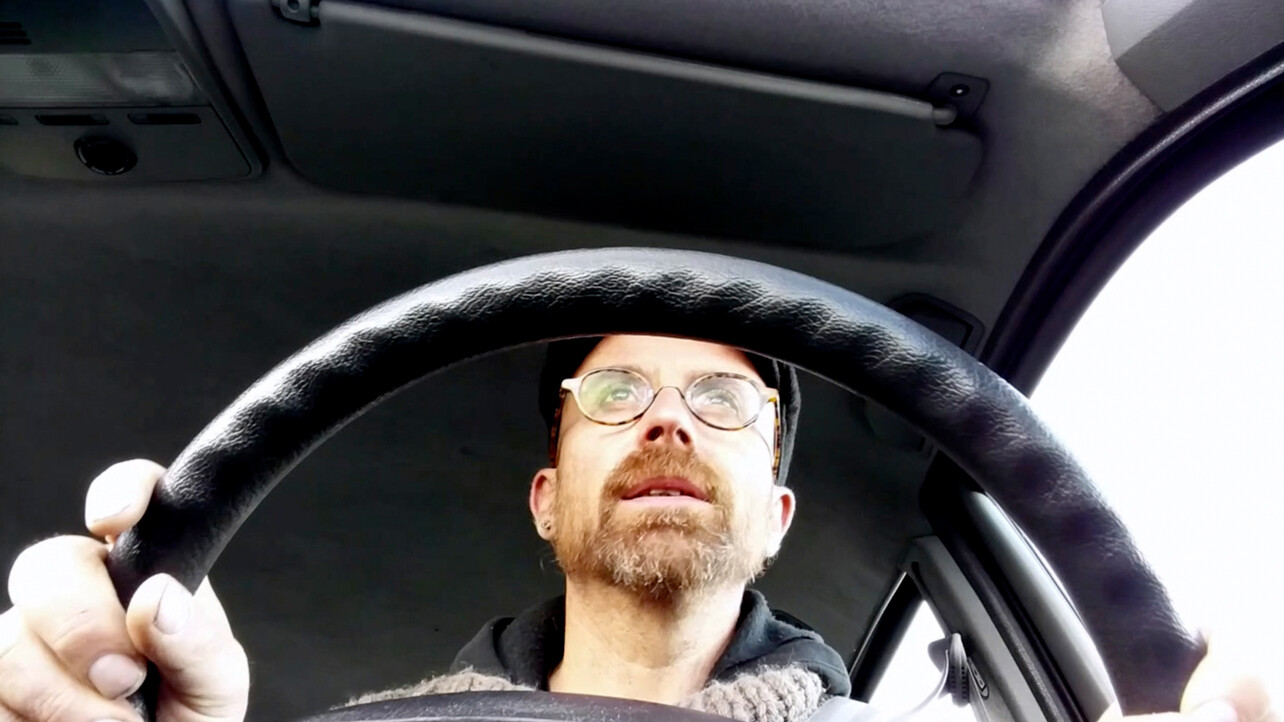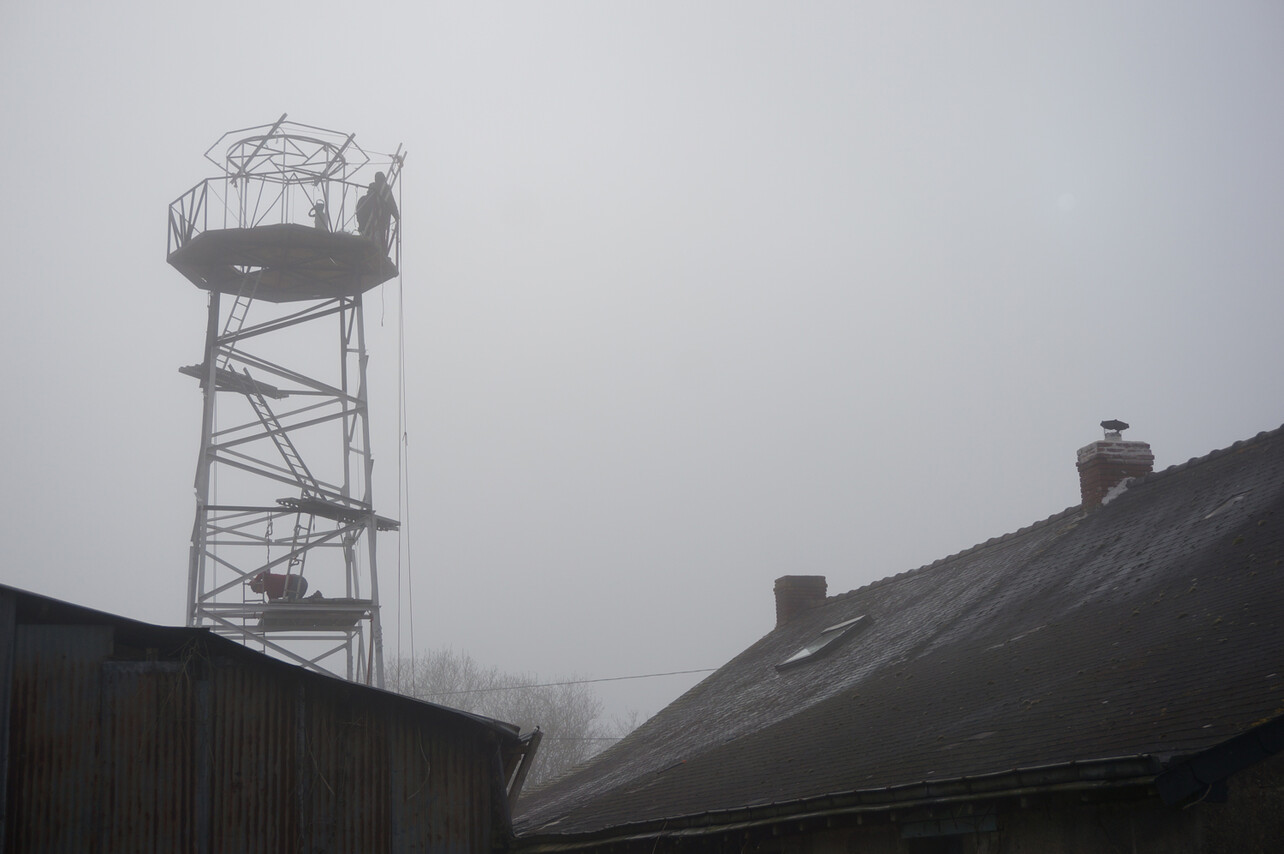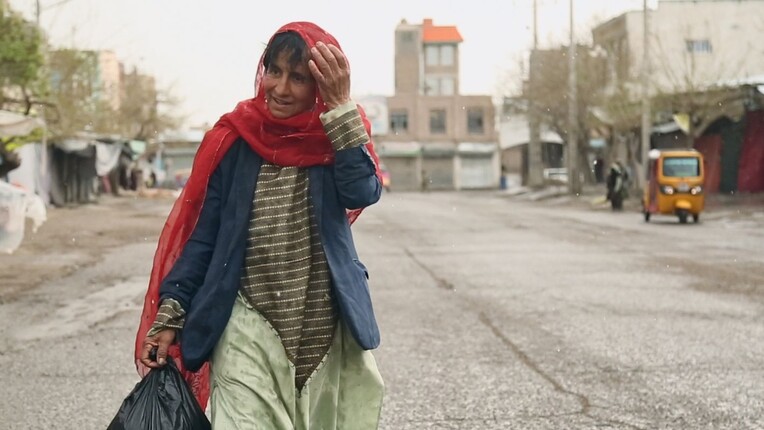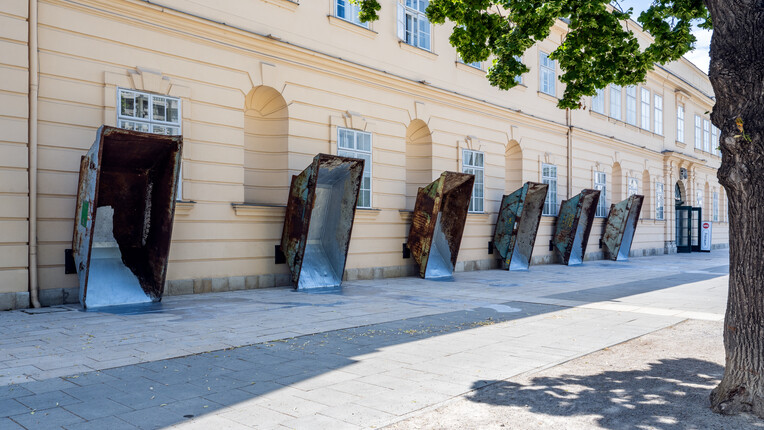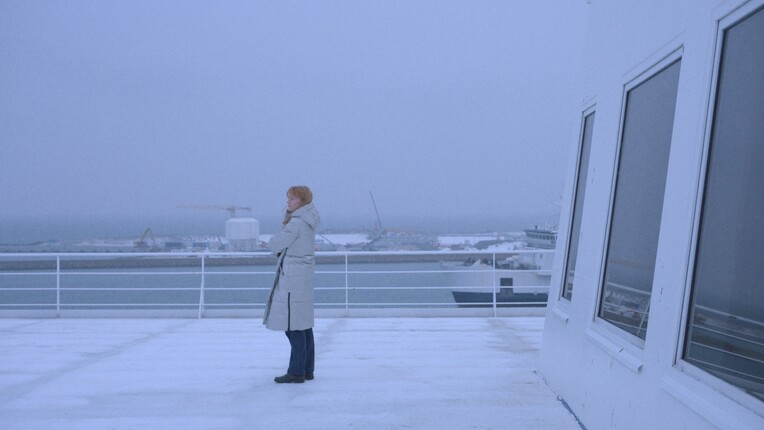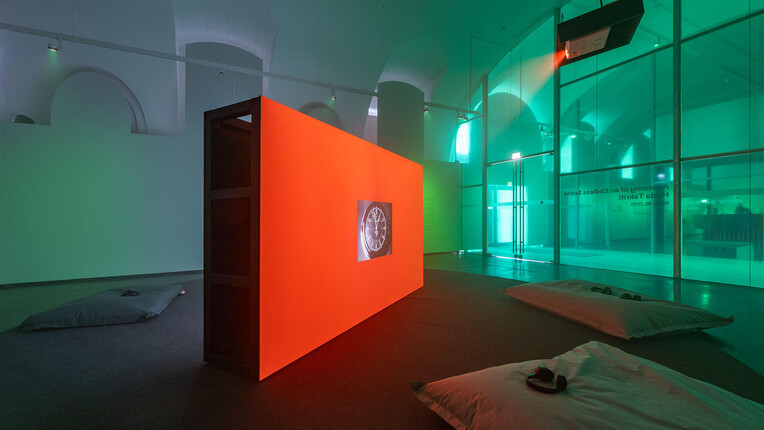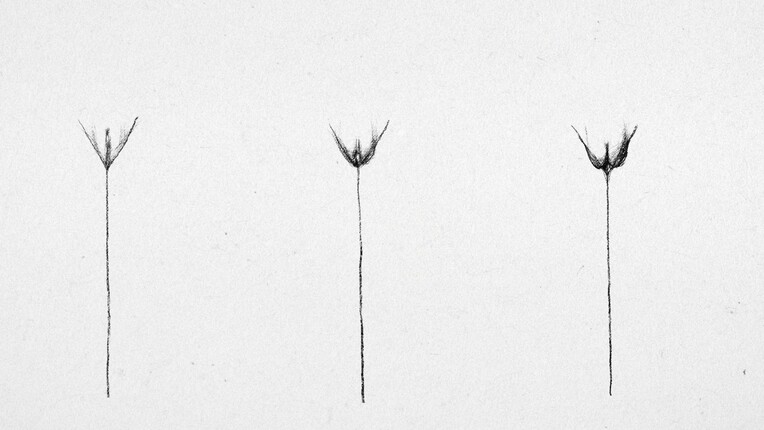
“We must not separate ethics and aesthetics.“
Jay Jordan and Isabelle Frémeaux of the Laboratory of Insurrectionary Imagination together with dozens of artists-activists from across Europe, organized the Climate Games event during the Paris COP21 conference of December 2015
The forms of action developed shaped the climate justice movement’s appearance. In the film "Barricade Cultures of the Future" shown in the exhibition "Overground Resistance", Jay Jordan describes artists’ role as one of involvement in the social movements that also constitute their material. Boundaries between art and activism dissolve altogether in this practice.
Jordan and Frémeaux live in the autonomous zone ZAD, which formed during resistance to an airport development project near Nantes in France.
This is the starting point for a film in the exhibition, "Notre Flamme Des Landes: The Illegal Lighthouse Against an Airport and Its World" (2018).
This conversation between Jay Jordan and Oliver Ressler, presented here in shortened and edited form, took place around the conference “Barricading the Ice Sheets” at Camera Austria in Graz in February 2020.
Oliver Ressler: Can you talk about your practice? How did it develop?
Jay Jordan (formerly John): I work with Isabelle Frémeaux in a collective called the Laboratory of Insurrectionary Imagination (Labofii) and I live on the ZAD of Notre Dame des Landes. I was trained as an artist in theatre and fine art. And then I had this kind of moment of realization, that I no longer wanted to make art that showed the world to people, but I wanted an art form that transformed our worlds directly. In the 1990s I experienced direct action movements against the construction of roads and climate-destroying infrastructure, and within those movements I saw direct action, I saw the practice of putting your body in the way of the machinery to protect forms of life, and suddenly I realised that this was performance that was both poetic and pragmatic, that changed reality – roads and airport runways were cancelled as a result. So, for the last 25 years, I worked as an artist embedded in the climate justice and anti-capitalist movements, applying creativity and imagination to them. And that means not making art about the multiple crises that engulf us, not making films or installations or performances inspired by protest, not creating more representations of politics, but being involved directly as an organizer to shape, sculpt and form the movements' practices. Since 2004, in the Laboratory of Insurrectionary Imagination with Isabelle Frémeaux we have been bringing artists and activists together, to co-design and choreograph forms of disobedience and post-capitalist life. It’s all about trying to find a symbiosis between the creative crafting of artists and the courage and social engagement of activists, to create a form that is in between art, life and activism.
Oliver Ressler: Could you give an example of your practice?
Jay Jordan: What does it mean as an artist to be involved in creating new forms of disobedience? Well, one example is that it would mean being involved in the collectives organising Climate camps, which temporarily squat a piece of land where a climate crime is planned. Climate Camps are self-managed and forms of prefigurative politics that show the desired world in the here and now rather than simply being protests “against” something. On camp, with several thousand people attending, everyone is crew and decisions are taken horizontally. All the energy for the camps is renewable, the food local and for over a week there are workshops in everything from anti-capitalist degrowth economics to how to build a hand-made wind turbine. It culminates with a mass direct action on the last day. In 2008 the camp was against building of a new coal-fired power station and the action idea was that we would block the power station using air, sea and land, and the Labofii took on the sea version, the water version. For that we set up this thing called The Great Rebel Raft Regatta, the GRRR. There was already a coal-fired power station, they wanted to knock it down and build a new one. So we were like, “Just knock it down! You don’t need to build a new one.” Along the river that passed the power station we buried a whole series of boats in the forest on the edge of the river and we then invited affinity groups to take part. These would be given a kind of pirate treasure map, they had to go and find their buried boat, like a treasure, and in the boat was a bottle of rum. So, they would find their boat in the forest, they would dig it up, they would pump it up, they would sleep in the boat at night, sleep in the forest and then at 7 in the morning everyone would go out, onto the river and take the power station. There was also rafts made out of old palettes and water bottles that were coming with vans and there were other groups that took those. So, there were the buried boats and the kind of half-made boats. One was called Operation Treasure Island, the other one was called Operation Ikea, because they were half-built. We got 150 people on the water, despite the fact that the police declared that no one was allowed on the water that day. And one of the boats actually blocked a third of the power station. There is a beautiful quote from Bertolt Brecht saying, “Art theatre is about training people in the pleasure of transforming reality.” And what I saw in that project was the pleasure that people had in this adventure. The adventure of taking the boat at night, going out into the river, blocking the power station... and there was one boat that blocked the power station and three of the people in that boat had never done this kind of action before and they are still involved in direct action. And I talked to them afterwards and for them it was that sense of adventure and play and fun of taking that boat on that day that really got them hooked. Adventure is addictive and I think as artists we should be able to create these moments of adventure – which are much more fun than a very boring march from A to B, with a placard that says “NO!”.
Oliver Ressler: How would you describe the role of artists (or more generally, cultural producers) in the climate justice movement internationally and in the states or regions where you are personally most active?
Jay Jordan: The role of artists in the climate justice movement is not to show the world the movement, is not to represent the problems. The role of the artists is to be involved in organizing that movement itself and in creating new forms of resistance and in thinking about the movement as a material. Not as an object that you then extract from to create a work, but the movement itself is matter. It is, like Beuys said, “social sculpture”, that you can sculpt that movement and create a movement that is more beautiful, more affective and more effective!
Oliver Ressler: The enormity of the challenge of the climate crisis requires that also the wider art world needs to transform radically. What are central aspects of this transformation from your point of view?
Jay Jordan: We have to change everything, faced with this utter crisis, which is not just C02 but soil depletion, deforestation, mass extinctions, ocean systems collapsing – we have to change everything! It’s not just revolutionaries saying this. No artist or street performer, acrobat or dramaturg, actor or designer has ever had to work in such a moment in history where it is much easier to imagine the collapse of life on earth than to imagine how we can find the right ways to live together. The IPPC, the UN climate scientists not known for their revolutionary positions, wrote in 2018 that if we want to avoid the worst of the climate catastrophe we had 12 years left for “rapid, far reaching and unprecedented changes in all aspects of society….”. That was in 2018. Now that leaves us 9 years. And for us at the Labofii – that means changing the way we all make art… And I think that includes changing and especially expanding the definition of art. It means healing it again and no longer having this separation between art and craft, between imagination and skill, between the beautiful and the useful, art and life. I think we have to get rid of all those separations. Our culture has to turn back towards life.
I think museums and cultural institutions have to stop being part of a kind of global metropolitan global abstraction, places of contemplation and reflection, and become public agoras for material action. Are the museums and cultural institutions working on local issues of infrastructure projects or social and ecological crimes in their local territories such as the new proposed runway for Vienna, or are they just taking the money from climate criminal sponsors? I think that’s a shift that has to happen, rather than having this uprooted disattached world of artists that just go from one show in a museum to another, to a residency, to an exhibition, to a biennial. We must break this spell of hypermobility of the metropolitan cultural class with its artists' “residencies”, white cubes and black boxes. Belonging nowhere and floating in an abstract vapid world, radical thought has no anchor in action, it is suitable to the status quo that the radical thinkers and makers are deprived of territory, material place, communities. In this way they are distanced from contexts where collective agency might sustainably transform the material world.
Oliver Ressler: In your abstract for the conference “Barricading the Ice Sheets” you used the term of “extractivist art”. Is an activist art already extractivist, if it is placed in an art institutional context?
Jay Jordan: It depends. I think you can have non-extractivist activist art in an art institution. But it has to have a resonance with what in that art institution is happening at the time. So maybe you are doing something about the cleaning – all art institutions have cleaners, who are normally paid nothing compared with the directors of the art institution. And the directors are paid loads compared with the artists who are working for the art institution. So if you are doing an activist work in that institution, which is talking about the inequality of wages and the power relationship between that, then maybe that makes sense. If you are doing it really directly, so you are engaging the cleaners and the director directly, you are not just making a kind of abstract intellectual, philosophical statement. If you are really trying to change the institution within, then I think it’s possible, but you need to be prepared to let go of your cultural capital, instead of censoring yourself, avoiding radicality for the sake of getting reinvited to the institution, putting your career in front of the politics. We must not separate ethics and aesthetics. If you are doing a performance piece in an institution about your experience of the climate struggles, for example inspired by the Ende Gelände actions against the brown coal mines in Germany – it is kind of extractivist, I think. Often the artist is deeply “concerned” by the issue, and the communities affected by it routinely become their material. But in the end, the most important thing is not how the work can be part of strategy against the problem, but that the material is extracted and transformed into good art. Their relationship with life is that of a resource rather than acts of reciprocity. The work does not really “give back” despite all its claims, what benefits most is the artist’s career and the further legitimisation of the institutions. Whether the work nourishes and sustains the social movements or communities invested in these issues is hardly ever on the agenda. Asking whether the work is useful or contributes in any way as some material solution to the issues it “deals with” is virtually a heresy, leading to accusations of instrumentalisation. If the art is used by political movements, it loses its fantasy of autonomy!
Oliver Ressler: Could you talk about the power of language in relation to climate disruption?
Jay Jordan: At the moment I am very questioned by this language of emergency. We know that emergency normally is an open door for forms of authoritarianism. Fascism feeds on emergencies. I think, yes, we are in an emergency. It is a huge paradox: how do you act directly in an emergency, in panic? How do you look long-term and not create a culture of panic, where in panic anything goes? I think the biggest danger in the next ten years is authoritarian forms of ecology, green fascism, we could call it. I think it is right around the corner. So, I think we need to somehow have this paradox of how do we face the emergency and not lose sight of justice. And not lose sight of freedom, and not lose sight of all those things which we have fought for hundreds of years.
Oliver Ressler: Where can we glimpse potential futures and new worlds grounded in social justice and ecological flourishing, and how can these be cultivated through artistic practices?
Jay Jordan: I think we are governed as much by infrastructure at the moment. Infrastructure creates forms of life. The construction of an airport, the construction of a pipeline, the extraction of a new refinery or a fracking site, these things construct the way we are governed. We need to block those infrastructures and at the same time create other forms of life. We need to block and build at the time. Show other ways, spark desires for other ways of living, not just say no, but yes at the same time.
We have to create spaces of hope and those spaces of hope are where you block something and you create another way of living. I live on the ZAD in Notre Dame des Landes and there we have managed to stop the building of an international airport. We did that by living in the way of the machines and setting up alternative forms of living together through material forms: through bakeries and cheese making and flour mills and farming and culture and music and new forms of assembly and relationships with nature. The proposition and protest entangled.
And what’s aesthetic about that for me, what is beautiful is taking actions that enable other forms of life, to continue living, to continue to unfold, to continue to develop and diversify. Blocking an airport means that the wetlands, the forests, the fields, the farms continue to live, they have not been turned into another concrete climate wrecking temple to hypermobility. And for me that is what’s beautiful, enabling life to live more.
